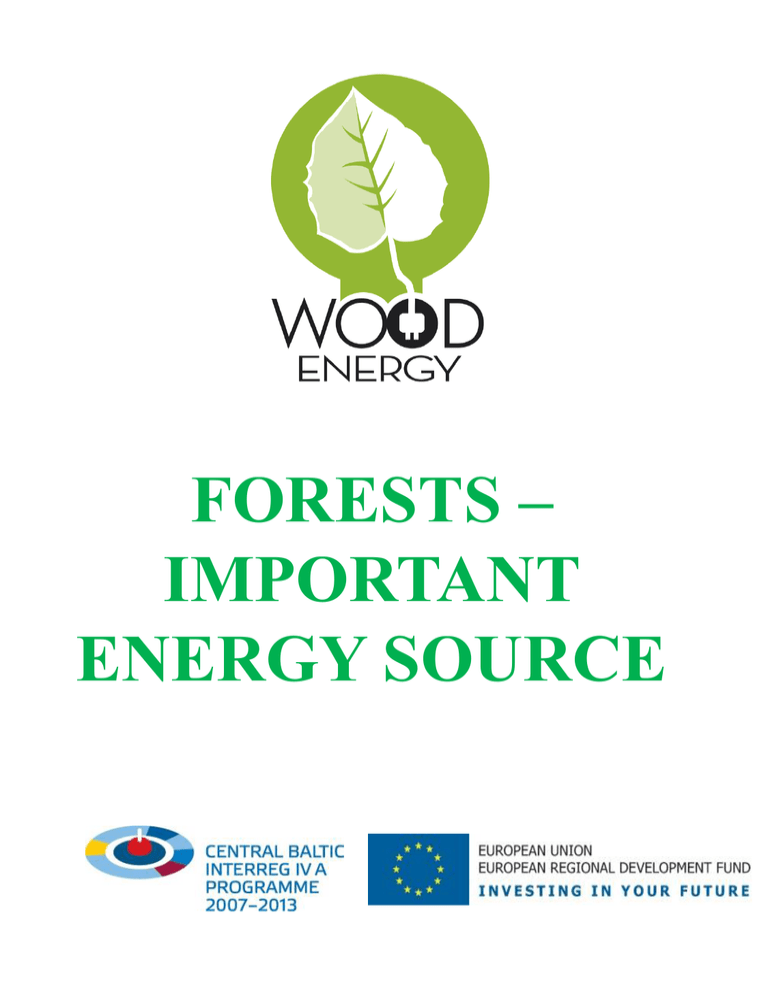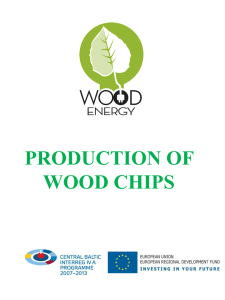3. Forests - Important Energy Source
advertisement

FORESTS – IMPORTANT ENERGY SOURCE Forests in the EU Apart from their importance for ecology and environment conservation forests are one of the Europe's major renewable resources which provide multiple benefits to the society and economy. In the EU, the forests and other wooded land take up about 177 million ha (over 40% of the land area), of which 130 million ha are available for wood supply. With Sweden and Finland as the leaders, forests cover a half of territory of the following seven EU member states: Sweden, Finland, Slovenia, Spain, Latvia, Estonia, Greece Forests in Sweden Important facts : 70% of the country’s territory is covered by forests; total forest area is 28.4 million hectares; total standing volume on productive forest land is about 2.9 billion m3; total annual growth is about 111 million m3 (productive forest) and around 117 million m3 (all land use categories); average standing volume per hectare is 131m3; average annual forest productivity is 5.3m3 of wood per hectare. Conifers are the dominant tree species in Sweden Sustainable management Wood energy, if recovered from sustainably managed resources with special regulations for harvesting and collecting energy wood, is a climate-neutral and socially viable source of renewable energy. In Sweden, the stands suitable for collecting energy wood are: spruce-dominated stands of no high biological, cultural, or social values; rot damaged stands; forest plantations on agricultural lands. Normally, logging residues are not collected on the sites prone to ground damages or having fine fraction soils, on wetland forests, high elevation sites and stands close to water catchment. To ensure sustainability it is recommended to leave at least 20% of logging residues in forest. Special guidelines regulate stump harvesting which is allowed in selected stands only with at least 15% of stumps left in the cutover. Amount of energy In most cases thewood estimates of the amount of energy wood are based on the characteristics of harvestable stands ripe for final fellings, thinnings or cleanings. The exploitable volume of energy wood depends on the amount of wood: potentially available; actually available; technically or economically available. In the stands where logging residues can be collected the potential amount of energy wood is estimated to be about 40% of the total timber volume which is normally reduced to 35% following the sustainability criteria and environmental constraints. In some cases, because of poor infrastructure, transportation distances, or the forest owner’s decision, the amount of energy wood to be recovered decreases, and that actually available is about 60% of the potential amount. Forest residues energy Woody biomass for energy is usually recovered in forest operations, using for it mainly residues from final felling and thinnings. In Sweden, forest biomass is collected in about 60% of final-felled areas. This approach is still seldom used in thinnings. There is a big potential for using stump-wood and small-sized trees for energy, but the methods of harvesting require further development. logging residues 20-30% timber – 70-80% stumpsup to 20% Proportion of different fractions of the aboveground tree biomass Wood fuel Wood energy is produced from: sawdust and other residues from sawmills and wood-related industries; other wood not demanded by the industry or trees of no industrial value; logging residues; fuelwood. Types of wood fuel : firewood; wood chips; pellets, granules and briquettes; charcoal. Wood fuel can be used for: household needs; heat supply (stoves, central heating furnaces, boiler houses, central heating plants (CHP), cogeneration stations); fuelling steam engines and steam turbines that generate electricity. Outturn of energy wood To estimate the approximate outturn of energy wood in forest operations some simple calculation methods are worked out based on long-term experience. Technological losses of about 20-40% are accounted for. In final felling the average outturn of energy wood is about 2030m3 per each 100m³ of timber. In mixed spruce and broadleaved stands it can reach 35-45% from the total volume of timber. In average 1 ha of forestland yields about 80m³ of energy wood, including firewood. The highest outturn of energy wood is in spruce stands, reaching more than 130m³/ha. Note: with increasing stand quality the outturn of timber assortments is getting higher compared to that of energy wood! Amount of forest fuels 2009 figures for Sweden: removals of forest fuels was 5,704,000m3 loose (87% from final felling and 13% from thinnings); tops and branches were collected from 115,095ha, and stumps from 5,010ha. In 2010, logging residues were extracted from 150,000ha of forestlands. According to expert estimates it is possible to increase the amount of energy produced from forest residues 4 to 6 times. In such a case, too, only the smallest part of the available volume will be used. The annual amount of energy in TWh generated from different types of wood residues Type of Totally Today Estimates residues available Forest 11 20-25 40 residues Stumps 0 10-12 40 Small trees 1 10-15 140









